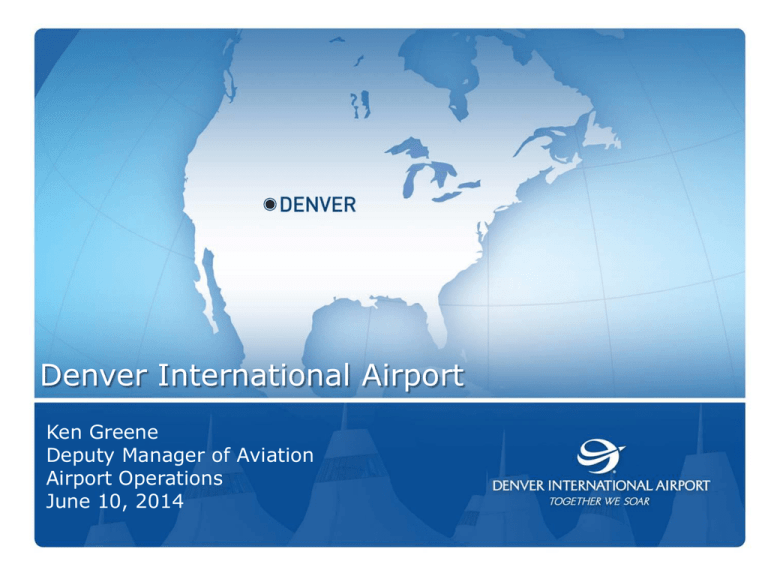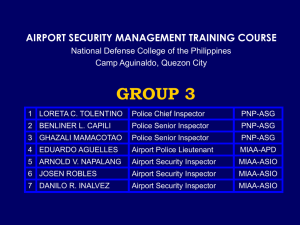Emergency Preparedness - Greene
advertisement

Denver International Airport Ken Greene Deputy Manager of Aviation Airport Operations June 10, 2014 1 AMAC DIVERSITY CONFERENCE AIRPORT EMERGENCY PREPAREDNESS 2 Emergency Operations Definition ‒ Events that: ‒ require the modification or shutdown of normal business operations, and ‒ may require that airport employees and passengers either seek shelter or evacuate the facility ‒ Examples: ‒ Tornado ‒ Facility accident / structural failure ‒ Natural gas leak ‒ Credible bomb threat ‒ Active shooter situation 3 4 Define Shelter vs. Evacuate ‒ Shelter ‒ Remain in the facility in a protected area such as a designated shelter, stairwell, restroom, baggage tunnel, or other area designated by airport management ‒ Evacuate ‒ Leave the facility and go to a remote location(s) as designated by airport management 5 6 Determine Information Flow Regarding Event ‒ Who is responsible for receiving and disseminating information? ‒ Information is normally received by Terminal Operations or Police if in the facility, or by Airside Operations if a weather event ‒ Immediately reported to the Operations Communication Center ‒ Operations Communication Center notifies senior leadership 7 8 Determine Information Flow Regarding Event ‒ What is the protocol for managing the event? ‒ Activate the Emergency Operations Center (EOC) in a location that is remote from the event ‒ Establish the Incident Command Structure (ICS) 9 10 Incident Command Structure (ICS) ‒ Incident Commander – Airport Operations ‒ Terminal Operations ‒ Denver Police ‒ Denver Fire ‒ Paramedics / Medical Services ‒ Emergency Management ‒ Customs And Border Protection ‒ Transportation Security Administration Incident Command Structure (ICS) – Cont’d ‒ Airline Representatives ‒ Air Traffic Control Tower ‒ Concessions Program Representative ‒ Ground Transportation ‒ Airport Security ‒ Media / Communications ‒ Airport Maintenance ‒ Airport Safety Assessment ‒ Review available information ‒ “Quickly” assess options with team ‒ MAKE A DECISION! ‒ Monitor the implications of the decision as new information becomes available, and prepare to make adjustments accordingly 13 Next Step Implement Communication Plan! 14 15 Activate Plan ‒ Airport Management ‒ Shutdown operations in terminal and concourses or airport-wide ‒ Immediately initiate public address announcements and establish timeframes for regular updates ‒ Station airport management staff positioned to assist employees and passengers and to execute plan ‒ Keep communications team updated as much as possible ‒ Provide information to employees and passengers via visual boards and social media 16 Activate Plan – cont’d ‒ Shutdown access to affected locations such as internal people mover systems, elevators and moving walkways, and roadways ‒ Activate Irregular Operations Plan / Aircraft Diversion Plan in coordination with the FAA Control Tower ‒ Activate Stranded Passenger Plan – hotel information ‒ Coordinate with Concessionaires ‒ Provide information re: status of the emergency as related to shutting down the operation, and sheltering employees and customers 17 18 Activate Plan – cont’d ‒ Coordinate with Airlines ‒ Address needs of deplaning passengers who would normally access evacuated area of the facility ‒ Address the needs of elderly and disabled passengers ‒ Activate Stranded Passenger Plan – hotel information ‒ Coordinate with Customs and Border Protection ‒ Address requirements for managing arriving international passengers, specifically directing them to safe areas and managing off loaded baggage 19 Activate Plan – cont’d ‒ Coordinate with Transportation Security Administration ‒ Shut down security checkpoints and direct airport employees and passengers to designated terminal or concourse locations or away from the facility ‒ Coordinate with Control Tower ‒ Establish process for handling airplanes that have just arrived at the gates ‒ Establish plans for flights that have just landed ‒ Establish plans to divert flights to other airports 20 21 Monitor Event ‒ Emergency Operations Center track up-to-date information regarding event status ‒ Continue public announcements ‒ Continue stakeholder updates ‒ Continue communications team updates 22 23 Secure Event ‒ Decision made by Incident Commander in consultation with senior management and with input from the airport management team ‒ Immediately notify communications team ‒ Immediately notify stakeholders 24 Resume Normal Operations ‒ Reinstitute operations functions, most importantly security functions ‒ Re-sterilize secured areas of the airport ‒ Update public announcements ‒ Manage the orderly flow of airport employees and passengers into the terminal and to the concourses ‒ Verify that all airport employees and passengers have vacated shelter locations 25 26 After Event Review/Evaluation ‒ Participation by all members of Incident Command Structure ‒ Conduct a review and critique of the management of the event ‒ Identify areas for improvement ‒ Schedule a follow-up meeting with all stakeholders to review the event and to identify changes needed to the plan ‒ Commit to a timeframe for implementing changes to the plan 27 28 Follow-up Action Steps ‒ Address additional airport management and stakeholder training requirements ‒ Implement modifications to Policies and Procedures ‒ Transmit “draft” plan modifications to all stakeholders for their review and comment ‒ Implement and disseminate revised plan 29 Denver International Airport Ken Greene Deputy Manager of Aviation Airport Operations June 10, 2014 30





